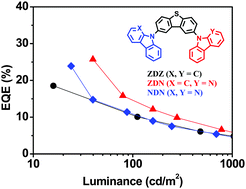High-performance bipolar host materials for blue TADF devices with excellent external quantum efficiencies†
Abstract
New bipolar host molecules composed of carbazole, pyridoindole, and dibenzothiophene (DBT) were synthesized for blue thermally activated delayed fluorescence (TADF)-based organic light-emitting diodes (OLEDs). 2,8-Di(9H-carbazol-9-yl)dibenzo[b,d]thiophene, 9-(8-(9H-carbazol-9-yl)dibenzo[b,d]thiophen-2-yl)-9H-pyrido[2,3-b]indole, and 2,8-bis(9H-pyrido[2,3-b]indol-9-yl)dibenzo[b,d]thiophene were prepared based on the selective reactivity at the 2,8-positions of DBT. The new symmetric and asymmetric host materials exhibited high triplet energies (2.89–2.95 eV). 4,5-Di(9H-carbazol-9-yl)phthalonitrile (2CzPN) was selected as an emitting dopant for achieving sky-blue emissions in TADF-OLEDs. 2CzPN-doped TADF-OLEDs, whose configuration is ITO (50 nm)/HATCN (7 nm)/TAPC (75 nm)/host:6% 2CzPN (20 nm)/TmPyPB (50 nm)/LiF (15 nm)/Al (100 nm), showed low driving voltages and high external quantum efficiencies (EQEs). These results are attributed to the well-controlled bipolar character of the host giving a better charge balance in the emitting layer. In particular, the device containing ZDN:6% 2CzPN showed an unprecedentedly high EQE of 25.7% (at 0.074 mA cm−2).

- This article is part of the themed collection: 10th Anniversary: Dedicated Authors

 Please wait while we load your content...
Please wait while we load your content...